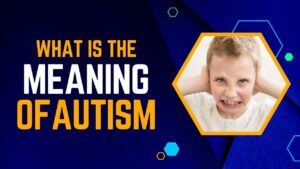Autism is a neurological condition that affects an individual’s social interaction, communication, and behavior. It is a spectrum disorder, meaning it affects individuals in varying degrees, from mild to severe.
In recent years, there has been a growing debate about the differences between classic autism (also known as typical autism) and virtual autism (also known as high-functioning autism). While both are on the autism spectrum, there are distinct differences between the two.
This article provides a comprehensive comparison of classic autism vs virtual autism, exploring their symptoms, diagnosis, and treatment options. Read on to learn more about these two variations of autism.
1. What is Classic Autism?
Classic Autism, also known as Typical Autism or Kanner’s Autism, is a developmental disorder that affects an individual’s ability to communicate, socialize, and engage in repetitive behaviors. It is usually diagnosed in early childhood, typically before the age of three. Children with classic autism often experience delays or difficulties in their communication skills, such as using and understanding language. They may also exhibit repetitive or self-stimulating behaviors, such as flapping their hands, rocking back and forth, or lining up toys.
Individuals with classic autism may struggle to interpret social cues, such as facial expressions, tone of voice, and body language, which can lead to difficulties in social interactions. They may also prefer routine and sameness and find change difficult to navigate. Additionally, classic autism is often associated with sensory sensitivities, including heightened sensitivity to light, sound, and touch.
Diagnosis of classic autism is typically made through a comprehensive evaluation that includes behavioral and developmental assessments, medical evaluations, and genetic testing. Treatment options for individuals with classic autism may include behavioral therapies, such as Applied Behavioral Analysis (ABA), speech and language therapy, and occupational therapy.
It is important to note that classic autism is a spectrum disorder, which means that individuals with classic autism can exhibit a wide range of symptoms and severity levels. While some individuals with classic autism may require significant support throughout their lives, others may be able to lead relatively independent lives with appropriate interventions and support.
Also Read:- 9 Myths & Facts about Autism- You should know

2. What is Virtual Autism?
Virtual Autism, also known as Social Communication Disorder, is a newly recognized form of autism spectrum disorder that affects an individual’s ability to communicate and interact with others through digital platforms such as social media and online gaming. Virtual Autism is believed to be caused by a combination of genetic and environmental factors, and it typically affects individuals who spend a significant amount of time engaged in online activities.
Individuals with Virtual Autism may exhibit similar symptoms to those with Classic Autism, such as difficulties in social communication and sensory sensitivities. However, the symptoms are often more pronounced in online settings and can lead to difficulties in forming and maintaining relationships with others.
Virtual Autism is a relatively new diagnosis, and there is still much to learn about its underlying causes and effective treatment options. However, some experts suggest that interventions aimed at developing strong communication and social-emotional skills, both online and offline, may be helpful for individuals with Virtual Autism.
So, Is Virtual Autism The Same As Autism?
It is important to note that Virtual Autism is not a separate disorder from Classic Autism, but rather a subtype that affects individuals in a specific context. As with Classic Autism, early diagnosis and intervention are crucial for individuals with Virtual Autism to lead fulfilling lives and reach their full potential.

3. Similarities between Classic Autism and Virtual Autism
Classic Autism and Virtual Autism may have distinct characteristics, but they share some similarities as well. Some of the shared similarities include:
- Social Communication Difficulties: Both Classic Autism and Virtual Autism are characterized by difficulties in social communication. Individuals with both forms of autism struggle to comprehend social cues and may have challenges initiating conversations or maintaining social relationships.
- Sensory Sensitivities: Individuals with Classic Autism and Virtual Autism may be hyper or hyposensitive to certain sensory inputs, such as touch, sound, or light. This sensitivity can be overwhelming and may lead to social withdraw.
- Repetitive Behaviors: People with both Classic and Virtual Autism may engage in repetitive behaviors, such as hand flapping, rocking, or fixations on certain objects. These behaviors are often used as a coping mechanism for sensory overload.
- Challenges in Transition: Both forms of autism may struggle with adapting to changes, such as transitioning from one activity or environment to another. This may lead to meltdowns or other challenging behaviors.
- Need for Support: Individuals with Classic Autism and Virtual Autism often need additional support from family, friends, and professionals to help them navigate social situations and learning environments. This support may include therapy, assistive technology, and adaptive strategies to enhance communication and social skills.
Understanding the similarities between Classic Autism and Virtual Autism helps families and professionals develop interventions that target both forms of autism effectively. Early diagnosis and intervention for both forms of autism are crucial for individuals to reach their full potential and lead fulfilling lives.

4. Differences between Classic Autism and Virtual Autism
While Classic Autism and Virtual Autism share some similarities, they also have distinct differences that set them apart.
Here are five differences between Classic Autism vs Virtual Autism:
- Onset: Classic Autism is typically diagnosed in early childhood, while Virtual Autism can be diagnosed in individuals of any age. Virtual Autism is often caused by a traumatic brain injury or other neurological condition and may develop later in life.
- Social Interaction: While both forms of autism have challenges with social interaction, individuals with Classic Autism may have a desire for social relationships but struggle to understand social cues. In contrast, individuals with Virtual Autism may not desire social interaction at all and may prefer isolation.
- Communication: Classic Autism is characterized by delays or difficulties in spoken language, while Virtual Autism may impact communication through speech as well as through other means, such as facial expressions and body language.
- Repetitive Behaviors: Although both Classic Autism and Virtual Autism may engage in repetitive behaviors, the types of behaviors may vary. Individuals with Classic Autism may repeat certain phrases or scripts, while individuals with Virtual Autism may repeat certain actions or movements.
- Sensory Processing: While both forms of autism may have sensory sensitivities, individuals with Virtual Autism may experience more severe or unpredictable reactions to sensory inputs. This can lead to challenges in everyday activities such as going to the grocery store or attending a crowded event.
Recognition of the differences between Classic Autism and Virtual Autism is essential to provide appropriate interventions and support for individuals with these conditions. As our understanding of autism continues to evolve, it is vital to recognize the unique challenges faced by individuals with different forms of autism.
Also Read:- Differences between Autism and Mental Retardation

5. Diagnosing Classic and Virtual Autism
Diagnosing Classic Autism and Virtual Autism requires a comprehensive evaluation by a qualified healthcare professional, such as a psychologist or psychiatrist.
Here are six aspects of the diagnostic process of Classic autism vs virtual autism for these conditions:
- Medical and Developmental History: Doctors will discuss medical and developmental history with the individual and their family. Classic Autism may show symptoms such as delays in language development, while Virtual Autism can be caused by a traumatic event or a medical condition such as a stroke or brain injury.
- Behavioral Observations: The doctor will evaluate an individual’s behavior to determine if they meet the criteria for Autism Spectrum Disorder (ASD), as outlined in the Diagnostic and Statistical Manual of Mental Disorders (DSM-5). Classic Autism may display repetitive behaviors, while Virtual Autism may present as a depression or anxiety disorder.
- Standardized Tests: Doctors may use standardized tests to evaluate social skills, communication, and language abilities. Tests like the Autism Diagnostic Observation Schedule (ADOS) can assist in diagnosing both Classic and Virtual Autism by measuring and comparing a variety of behaviors.
- Sensory and Motor Screening: Another important aspect of the evaluation is assessing an individual’s sensory and motor function. Virtual Autism may have visual impairments or hearing loss that can impact their ability to interact with their environment.
- Family Assessment: Family members are often asked to fill out questionnaires to provide a better understanding of an individual’s social interactions and behaviors. Family history can also be used to identify possible genetic factors that contribute to the development of Classic Autism.
- Other Medical Testing: Doctors may order additional medical tests such as genetic testing or brain imaging to rule out other conditions that may cause similar symptoms.
Overall, diagnosis of both Classic and Virtual Autism requires a multi-faceted approach that considers the individual’s history, behavior, and family dynamics. While there are similarities between these two forms of Autism, understanding the differences is critical for providing appropriate interventions and ensuring the best possible outcomes for individuals with Autism Spectrum Disorder.

6. Treatment options for Classic Autism vs Virtual Autism
Several treatments options are available for individuals diagnosed with Classic autism and Virtual Autism. Treatment plans may vary based on the individual’s age, symptoms, and the severity of their condition. Here are seven treatment options that can help improve the quality of life for individuals with Classic and Virtual Autism:
- Applied Behavior Analysis (ABA): This type of therapy uses behavioral techniques to improve an individual’s social, communication, and adaptive skills. ABA therapy focuses on positive reinforcement to increase desired behaviors and decrease unwanted behaviors.
- Occupational Therapy (OT): Occupational therapists work with individuals to improve their ability to participate in daily activities and improve their sensory processing. OT can help individuals develop skills to manage their physical, social, and emotional needs.
- Speech Therapy: Speech therapy can improve an individual’s communication skills by teaching them how to use language effectively. This type of therapy focuses on improving verbal and nonverbal communication, such as gestures and facial expressions.
- Cognitive Behavioral Therapy (CBT): This therapy addresses the thoughts and feelings that drive an individual’s behaviors. CBT can help individuals with Classic and Virtual Autism learn how to cope with stress, anxiety, and depression.
- Medication: Medication may be prescribed to treat comorbid conditions, such as seizures, anxiety, or depression. Most medications prescribed for individuals with Classic and Virtual Autism aim to alleviate symptoms and improve behavior.
- Sensory Integration Therapy: Sensory integration therapy is a type of therapy that aims to improve an individual’s sensory processing. This therapy can help individuals manage sensory overload and improve their ability to participate in daily activities.
- Special Education: Special education programs provide tailored learning environments for children with Classic and Virtual Autism. These programs focus on developing skills that can help these individuals learn and communicate more effectively.
The treatment plan for Classic and Virtual Autism should be developed based on the individual’s unique needs. It is essential to work closely with healthcare professionals to design a comprehensive treatment plan that addresses all aspects of the individual’s physical, emotional, and social needs.

Also Read:- Relationship Development Intervention (RDI) & how to use in Autism treatment.
7. How to recover from virtual autism?
Recovering from virtual autism requires a comprehensive and individualized approach. It is important to note that virtual autism is not a recognized medical condition, but rather a term that has been used to describe individuals who may exhibit symptoms similar to autism spectrum disorder in virtual environments.
The first step in the recovery process is to seek a professional evaluation and diagnosis from a qualified healthcare provider or specialist in autism spectrum disorders. They will be able to assess the individual’s symptoms and determine if they meet the criteria for an autism spectrum disorder diagnosis or if there may be other underlying factors at play.
Once a diagnosis has been made, the next step is to develop a personalized treatment plan. This plan may include a range of therapeutic interventions such as behavioral therapy, occupational therapy, speech therapy, and social skills training. The specific interventions used will depend on the individual’s unique needs and goals.
In addition to therapy, it can also be beneficial to provide individuals with support and accommodations in virtual settings. This may include providing clear and concise instructions, minimizing sensory distractions, and creating structured routines and schedules.
Education and awareness are also key components of the recovery process. By educating yourself and others about autism spectrum disorders and virtual autism, you can promote understanding and acceptance within virtual environments. This can help to create more inclusive and supportive virtual communities.
Lastly, it is important to approach the recovery process with patience and persistence. Recovery from virtual autism may take time, and progress may be gradual. By staying committed to the treatment plan and seeking support from professionals, friends, and family, individuals can make significant strides towards improving their functioning and well-being in virtual environments.
8. Conclusion
In conclusion, understanding the future of machine learning, the importance of self-editing, and the different treatment options available for Classic and Virtual Autism is crucial for anyone interested in these fields. Quantum computing and AutoML are just a few of the exciting developments in the world of machine learning that hold immense potential for the future.
The art of self-editing is an integral part of the writing process, and it is important for writers to understand the differences between editing and proofreading. Finally, for individuals diagnosed with Classic and Virtual Autism, a comprehensive treatment plan that addresses their unique needs can significantly improve their quality of life. Seeking out the right healthcare professionals and resources can lead to positive outcomes and improved overall well-being.
9. Classic Autism vs Virtual Autism FAQs
Virtual autism is a term that is often used to describe a condition where individuals exhibit autistic-like behaviors and characteristics primarily in online or virtual environments. This phenomenon has become more prevalent with the rise of social media platforms and online communities.
To learn more about the symptopms of Virtual Autism check this Characteristics and Symptoms of Virtual Autism
It is important to note that virtual autism is not a clinically recognized disorder, but rather a concept that has emerged to describe certain behaviors and experiences observed online. Further research is needed to understand the underlying causes and implications of virtual autism.
Virtual autism is a term that is often used to describe a condition where individuals exhibit autistic-like behaviors and characteristics primarily in online or virtual environments. This phenomenon has become more prevalent with the rise of social media platforms and online communities.
Virtual reality therapy has shown promise as a treatment option for individuals with autism. It allows for a controlled and immersive environment where individuals can practice social interactions, communication skills, and sensory integration in a safe and supportive setting.
By creating virtual scenarios that mimic real-life situations, individuals with autism can gradually learn and adapt their responses, leading to improved social and communication skills.
The concept of virtual autism refers to individuals who display symptoms similar to those with autism but do not meet the diagnostic criteria for an official autism spectrum disorder. While virtual autism is not recognized as a clinical diagnosis, there is ongoing research exploring whether the symptoms associated with virtual autism can be reversed or mitigated.






My twin 4 year old boys have virtual Autism. Four months with no screens no Cocomelon kind of cartoons there receptive language has gone through the roof I get eye contact And some stemming behaviors have gone away. Also, violent tempers have gone away They just turned five and I’m telling you they are new children. They are still have some issues were working on, but it had to be the TV and iPad. I just know her from the depths of my soul. I am just so blown away by the transformation and it’s only been four months. I’m so happy I was devastated thinking that there was no help but now learning about her to autism and stopping off on the computer and TV so they can start to learn and see me talk and interact I am so happy for them and I pray that studies will come out to help all the kids right now that are similar and parents don’t even know why.
I found your distinction between classic autism and virtual autism fascinating. It made a lot of sense to me, especially the part about how virtual autism is often invisible to the naked eye. I’ve seen people exhibit symptoms of virtual autism without realizing it themselves. The comparison to classic autism really helped me understand the differences. Thanks for sharing your insights!